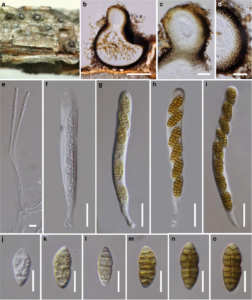Allophaeosphaeria cytisi Wanasinghe, Camporesi, E.B.G. Jones & K.D. Hyde.
Index Fungorum number: IF551409; Facesoffungi number: FoF00946; Fig. 1
Etymology – Name reflects the host genus Cytisus, from which the species was collected.
Holotype – MFLU 15-1502
Saprobic on dead herbaceous branches. Sexual morph: Ascomata 500 – 550 μm high, 400 – 450 μm diam. (x̄ = 526.3 × 423.3 μm, n = 10), solitary, scattered, immersed to erumpent, obpyriform, dark brown to black, coriaceous, ostiolate. Ostiole 190 – 220 μm high, 150 – 200 μm diam. (x̄ = 206.4 × 172 μm, n = 5), papillate, black, smooth, filled with hyaline cells, appearing as a white ring around ostiole. Peridium 10 – 20 μmwide at the base, 20 – 40 μm wide in sides, comprising 6 – 8 layers, outer layer heavily pigmented, comprising blackish to dark brown, thick – walled cells of textura angularis, inner layer composed of brown, thin – walled cells of textura angularis. Hamathecium comprising numerous, 2 – 2.5 μm (n = 30) wide, filamentous, branched, septate, pseudoparaphyses. Asci 110 – 140 × 10 – 15 μm (x̄ = 124.2 × 13.1 μm, n = 40), 8 – spored, bitunicate , fissitunicate, cylindrical, pedicel furcate and up to 15 – 25 μm long, rounded and thick – walled at the apex, with a ocular chamber. Ascospores 20 – 25 × 8 – 10 μm (x̄ = 21.5 × 9.3 μm, n = 50), mostly uniseriate, initially hyaline, becoming yellowish brown at maturity, ellipsoidal, muriform with 6–8 transverse septa and 3–7 vertical septa, strongly constricted at the central septa, weakly constricted at the other septa, with conical and narrowly rounded ends, lacking a mucilaginous sheath. Asexual morph: Undetermined.
Culture characteristics – Colonies on PDA reaching 20 – 25 mm diam. in 21 days, olivaceous-grey in center, pale olivaceous-grey in outer region, spreading with moderate aerial mycelium, and smooth, even margins; olivaceous-grey from below.
Material examined – ITALY, Arezzo Province, Casuccia di Micheli in Quota, dead and hanging branches of Cytisus sp. (Fabaceae), 20 June 2012, E. Camporesi(MFLU 15-1502, holotype), ex-type living culture, MFLUCC 15-0649.
Notes – Allophaeosphaeria cytisi has muriform ascospores and cylindrical asci similar to those characterized in Cucurbitaria, Camarosporium arezzoensis Tibpromma et al., Mycoporum elabens (A. Massal.) Flot. ex Nyl. and Teichospora trabicola Fuckel. Multigene analyses of ITS, LSU and SSU sequence data (Fig. 40) indicate that A. cytisi belongs in Phaeosphaeriaceae. Allophaeosphaeria cytisi forms a distinct clade from Phaeosphaeria sensu stricto. Allophaeosphaeria cytisi differs from A. clematidis and A. dactylidis in its uniseriate ascospores arranged in cylindrical asci, and having 6 – 8 transverse septa and 3 – 7 vertical septa, while A. clematidis and A. dactylidis have cylindric – clavate asci with 1 – 2 – seriate ascospores having 4 – 6 transverse septa, 3 – 4 vertical septa or 3 – 5 transverse septa, with 1–3 vertical septa, respectively. Allophaeosphaeria muriformia differs from A. clematidis in having overlapping 2 – 3 – seriate, comparatively large (x̄ = 56 × 26 μm), oblong to narrowly oblong ascospores.

Fig. 1 Allophaeosphaeria cytisi (holotype) a Appearance of ascomata on host substrate. Note the papilla with white circle around the ostiole b Section of ascoma c Close up of ostiole d Peridium e Pseudoparaphyses f – i Asci j – o Ascospores. Scale bars: b = 200 μm, c, d = 50 μm, e = 5 μm, f – i=20 μm, j – o=10 μm.
